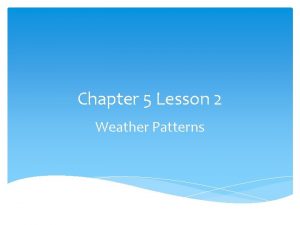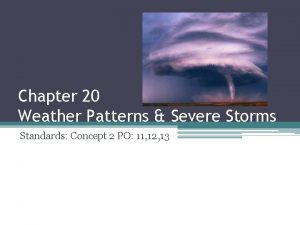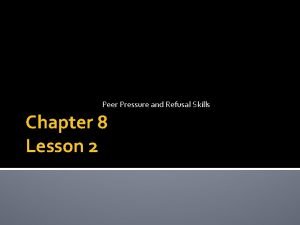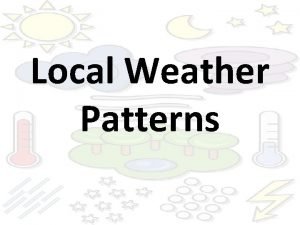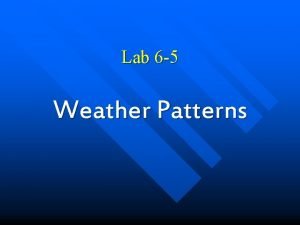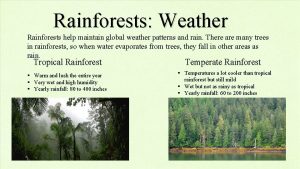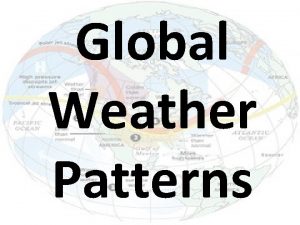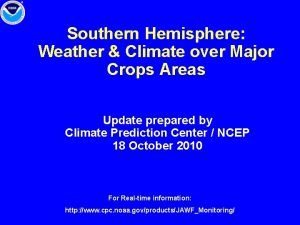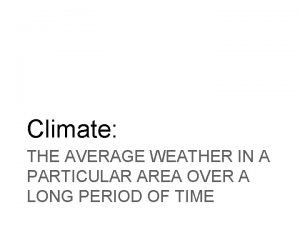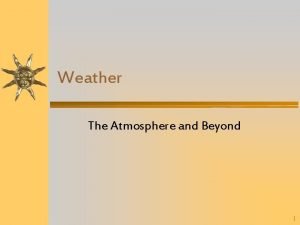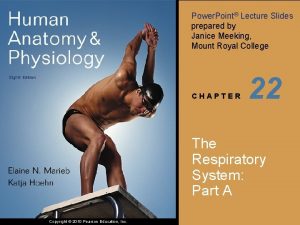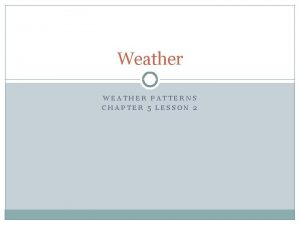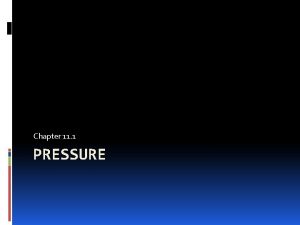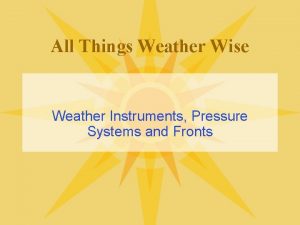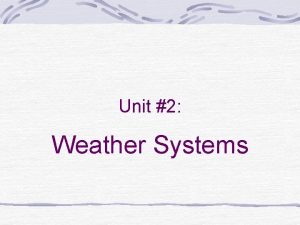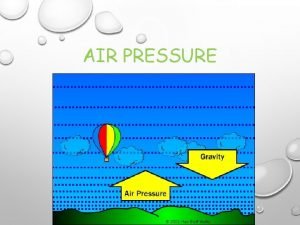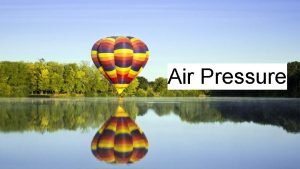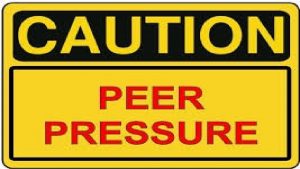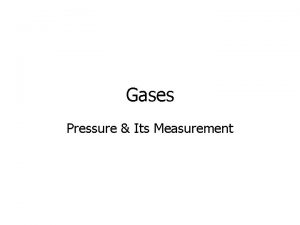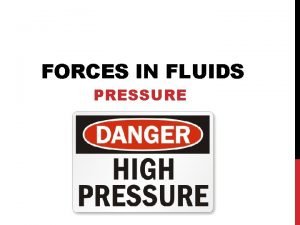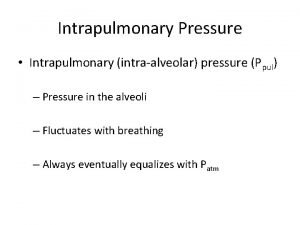Chapter 5 Lesson 2 Weather Patterns Pressure Systems


























- Slides: 26

Chapter 5 Lesson 2 Weather Patterns

Pressure Systems A high-pressure system is a large body of circulating air with high pressure at its center and lower pressure outside of the system.

Pressure Systems (cont. ) A low-pressure system is a large body of circulating air with low pressure at its center and higher pressure outside of the system.

Air Masses Air masses are large bodies of air with distinct temperature and moisture characteristics. An air mass forms when a large high pressure system lingers over an area for several days. As a high pressure system comes in contact with Earth, the air in the system takes on the temperature and moisture characteristics of the surface below it.

Air Masses (cont. ) Five main air masses impact climate across North America.

Air Masses (cont. ) Air masses are classified by their temperature and moisture characteristics. Continental air masses form over land. Maritime masses form over water.

Air Masses (cont. ) Tropical air masses form in the warm equatorial regions. Polar air masses form over cold regions. Arctic and antarctic air masses form near the poles, over the coldest regions of the globe.

Fronts A weather front is a boundary between two air masses. Changes in temperature, humidity, clouds, wind, and precipitation are common at fronts.

Fronts (cont. ) When a colder air mass moves toward a warmer air mass, a cold front forms.

Fronts (cont. ) A warm front forms when lighter, warmer air moves toward colder, heavier air.

Fronts (cont. ) When the boundary between two air masses stalls, the front is called a stationary front.

Fronts (cont. ) When a fastmoving cold front catches up with a slowmoving warm front, an occluded or blocked front forms.

Severe Weather Thunderstorms have warm temperatures, moisture, and rising air, which may be supplied by a lowpressure system. Thunderstorms have a three-stage life cycle: the cumulus stage, the mature stage, and the dissipation stage.

Severe Weather (cont. ) The cumulus stage is dominated by cloud formation and updrafts. After the cumulus stage, downdrafts, which are air currents moving vertically toward the ground, begin to form.

Severe Weather (cont. ) In the mature stage, heavy winds, rain, and lightning dominate the area. In the dissipation stage, updrafts stop, winds die down, lighting ceases, and precipitation weakens.

Severe Weather (cont. ) A tornado is a violent, whirling column of air in contact with the ground. Tornadoes form when thunderstorm updrafts begin to rotate. Tornado Alley is the name given to the area of the central United States that experiences the most tornadoes.

Severe Weather (cont. ) An intense tropical storm with winds exceeding 119 km/h is a hurricane.


Severe Weather (cont. ) A blizzard is a violent winter storm characterized by freezing temperatures, strong winds, and blowing snow.

Severe Weather (cont. ) The U. S. National Weather Service issues watches and warning for different types of severe weather. A watch means that severe weather is possible. A warning means that severe weather is already occurring.

• Low-pressure systems, high-pressure systems, and air masses all influence weather.

• Weather often changes as a front passes through an area.

• The National Weather Service issues warnings about severe weather such as thunderstorms, tornadoes, hurricanes, and blizzards.

What are large bodies of air with distinct temperatures and moisture characteristics? A. B. C. D. high-pressure systems low-pressure systems weather fronts air masses

Which of these form over land near the North Pole and contain cold, dry air? A. B. C. D. continental air masses arctic air masses polar air masses maritime air masses

A large body of circulating air with low pressure at its center and higher pressure outside of the system is called what? A. B. C. D. an air mass a low-pressure system a high-pressure system a continental polar ice mass
 Lesson 2 weather patterns answer key
Lesson 2 weather patterns answer key Chapter 20 weather patterns and severe storms
Chapter 20 weather patterns and severe storms Chapter 20 weather patterns and severe storms
Chapter 20 weather patterns and severe storms Lesson outline lesson 3 weather forecasts answer key
Lesson outline lesson 3 weather forecasts answer key Chapter 8 lesson 2 peer pressure and refusal skills
Chapter 8 lesson 2 peer pressure and refusal skills An assertive response to peer pressure is
An assertive response to peer pressure is Weather map station model light rain
Weather map station model light rain Whether the weather be cold tongue twister
Whether the weather be cold tongue twister Whatever the weather poem
Whatever the weather poem It's windy weather it's stormy weather
It's windy weather it's stormy weather Whether the weather is fine
Whether the weather is fine Heavy weather by weather report
Heavy weather by weather report Capital weather gang weather wall
Capital weather gang weather wall The equator weather
The equator weather Lab: weather patterns
Lab: weather patterns Amazon rainforest weather
Amazon rainforest weather Global weather patterns
Global weather patterns Southern hemisphere weather patterns
Southern hemisphere weather patterns Insolaton
Insolaton Why does low air pressure usually indicate stormy weather
Why does low air pressure usually indicate stormy weather Dating serves several important functions that include:
Dating serves several important functions that include: Associations and correlations in data mining
Associations and correlations in data mining Patella baja
Patella baja Pressure support vs pressure control
Pressure support vs pressure control Pressure mapping for pressure ulcers
Pressure mapping for pressure ulcers Intrapulmonary pressure vs intrapleural pressure
Intrapulmonary pressure vs intrapleural pressure Oncotic pressure vs osmotic pressure
Oncotic pressure vs osmotic pressure
